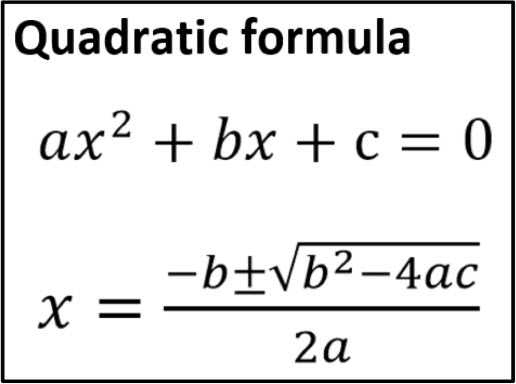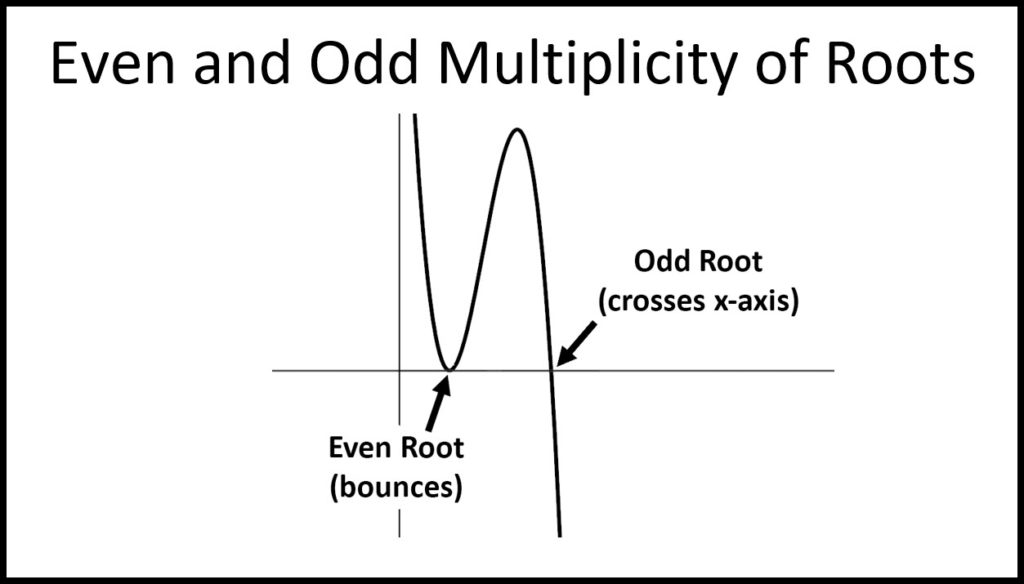Andymath.com features free videos, notes, and practice problems with answers! Printable pages make math easy. Are you ready to be a mathmagician?
Notes


Problems and Videos
Solve for x using the quadratic formula
\(\textbf{1)}\) \( x^2+10x-24=0 \)
\(\textbf{2)}\) \( 2x^2+7x=4 \)
\(\textbf{3)}\) \( x^2-6x+8=0 \)
\(\textbf{4)}\) \( x^2+4x+8=0 \)
\(\textbf{5)}\) \( x^2-4x+4=0 \)
Find the discriminant and the number and types of roots
\(\textbf{6)}\) \( x^2+6x+24=0 \)
\(\textbf{7)}\) \( 3x^2+7x=4 \)
\(\textbf{8)}\) \( 4x^2-6x+9=0 \)
See Related Pages\(\)
\(\bullet\text{ Adding and Subtracting Polynomials}\)
\(\,\,\,\,\,\,\,\,(4d+7)−(2d−5)…\)
\(\bullet\text{ Multiplying Polynomials}\)
\(\,\,\,\,\,\,\,\,(x+2)(x^2+3x−5)…\)
\(\bullet\text{ Dividing Polynomials}\)
\(\,\,\,\,\,\,\,\,(x^3-8)÷(x-2)…\)
\(\bullet\text{ Dividing Polynomials (Synthetic Division)}\)
\(\,\,\,\,\,\,\,\,(x^3-8)÷(x-2)…\)
\(\bullet\text{ Synthetic Substitution}\)
\(\,\,\,\,\,\,\,\,f(x)=4x^4−3x^2+8x−2…\)
\(\bullet\text{ End Behavior}\)
\(\,\,\,\,\,\,\,\, \text{As } x\rightarrow \infty, \quad f(x)\rightarrow \infty \)
\(\,\,\,\,\,\,\,\, \text{As } x\rightarrow -\infty, \quad f(x)\rightarrow \infty… \)
\(\bullet\text{ Completing the Square}\)
\(\,\,\,\,\,\,\,\,x^2+10x−24=0…\)
\(\bullet\text{ Quadratic Formula and the Discriminant}\)
\(\,\,\,\,\,\,\,\,x=-b \pm \displaystyle\frac{\sqrt{b^2-4ac}}{2a}…\)
\(\bullet\text{ Complex Numbers}\)
\(\,\,\,\,\,\,\,\,i=\sqrt{-1}…\)
\(\bullet\text{ Multiplicity of Roots}\)
\(\,\,\,\,\,\,\,\,\) \(…\)
\(…\)
\(\bullet\text{ Rational Zero Theorem}\)
\(\,\,\,\,\,\,\,\, \pm 1,\pm 2,\pm 3,\pm 4,\pm 6,\pm 12…\)
\(\bullet\text{ Descartes Rule of Signs}\)
\(\,\)
\(\bullet\text{ Roots and Zeroes}\)
\(\,\,\,\,\,\,\,\,\text{Solve for }x. 3x^2+4x=0…\)
\(\bullet\text{ Linear Factored Form}\)
\(\,\,\,\,\,\,\,\,f(x)=(x+4)(x+1)(x−3)…\)
\(\bullet\text{ Polynomial Inequalities}\)
\(\,\,\,\,\,\,\,\,x^3-4x^2-4x+16 \gt 0…\)
In Summary
The quadratic formula is a useful tool for solving quadratic equations and understanding the behavior of quadratic functions. It is a mathematical formula that provides the solutions to a quadratic equation, which is an equation of the form \(ax^2 + bx + c = 0\). The quadratic formula is given by the equation \(x = \frac{-b \pm \sqrt{b^2 – 4ac}}{2a} \) where a, b, and c are the coefficients of the quadratic equation and x is the variable.
The discriminant of a quadratic equation is the part of the quadratic formula under the square root sign, which is \(D=b^2 – 4ac\). The value of the discriminant determines the number and type of solutions to the quadratic equation. If the discriminant is positive, the quadratic equation has two real solutions. If the discriminant is zero, the quadratic equation has one real solution. And if the discriminant is negative, the quadratic equation has no real solutions (But still has 2 complex solutions).
The quadratic formula and the discriminant are typically introduced in algebra 2 or precalculus, which are high school or college level math courses. In these courses, students learn about various types of equations and functions, including quadratic equations and quadratic functions, and how to solve them using the quadratic formula and other techniques.
The quadratic formula is that can be derived using a technique called completing the square. Most students don’t need to know this for class, but it is still a fun thing to know. Here is a 3 minute Youtube video going over how to derive the quadratic formula.
One real-world example of the quadratic formula and the discriminant is in the field of engineering, where they are used to solve problems involving forces and deformations. For example, consider a beam that is supported at each end and subjected to a load at its center. The deflection of the beam at the center can be modeled by a quadratic equation, and the solutions to this equation can be found using the quadratic formula.
In this case, the deflection of the beam is given by the equation y = ax^2 + bx + c, where y is the deflection at the center of the beam, x is the distance from the center, and a, b, and c are constants that depend on the properties of the beam and the applied load. The solutions to this equation correspond to the points where the beam has zero deflection, and these solutions can be found using the quadratic formula.
The discriminant in this case is the part of the quadratic formula under the square root sign, which is b^2 – 4ac. The value of the discriminant determines the number and type of solutions to the quadratic equation, and this information can be used to determine the behavior of the beam. For example, if the discriminant is positive, the quadratic equation has two real solutions, which correspond to two points of zero deflection. If the discriminant is zero, the quadratic equation has one real solution, which corresponds to a single point of zero deflection. And if the discriminant is negative, the quadratic equation has no real solutions, which means the beam has no points of zero deflection.
Topics to The Quadratic Formula and the Discriminant
There are many topics in mathematics that are related to the quadratic formula and the discriminant. Some of these topics include:
Polynomial equations and functions: The quadratic formula is a specific case of a more general class of equations and functions known as polynomial equations and functions. These are equations and functions that can be written in the form ax^n + bx^(n-1) + … + c = 0, where a, b, …, c are constants and n is a positive integer. The quadratic formula can be extended to solve equations and functions of this form, and many of the properties and behaviors of quadratic equations and functions carry over to the more general case of polynomial equations and functions.
Complex numbers: The quadratic formula involves the square root of a quantity that may be negative, which leads to the concept of complex numbers. Complex numbers are numbers that have both a real part and an imaginary part, and they are often represented in the form a + bi, where a is the real part and b is the imaginary part. In the context of the quadratic formula, complex numbers are used to represent solutions to quadratic equations that have no real solutions.
Systems of equations: The quadratic formula can be used to solve systems of equations that contain quadratic equations. A system of equations is a set of equations that are solved simultaneously, and it can have multiple solutions or no solutions. The quadratic formula can be used to solve systems of equations that contain quadratic equations by finding the solutions to each equation individually and then using these solutions to find the solutions to the system as a whole.
Graphs and functions: The quadratic formula is often used in conjunction with graphs and functions in order to understand the behavior of parabolas.
Inequalities: The quadratic formula can be used to solve quadratic inequalities, which are inequalities that involve quadratic equations. A quadratic inequality is an inequality of the form ax^2 + bx + c > 0, ax^2 + bx + c < 0, ax^2 + bx + c >= 0, or ax^2 + bx + c <= 0, where a, b, and c are constants and x is the variable.
About Andymath.com
Andymath.com is a free math website with the mission of helping students, teachers and tutors find helpful notes, useful sample problems with answers including step by step solutions, and other related materials to supplement classroom learning. If you have any requests for additional content, please contact Andy at tutoring@andymath.com. He will promptly add the content.
Topics cover Elementary Math, Middle School, Algebra, Geometry, Algebra 2/Pre-calculus/Trig, Calculus and Probability/Statistics. In the future, I hope to add Physics and Linear Algebra content.
Visit me on Youtube, Tiktok, Instagram and Facebook. Andymath content has a unique approach to presenting mathematics. The clear explanations, strong visuals mixed with dry humor regularly get millions of views. We are open to collaborations of all types, please contact Andy at tutoring@andymath.com for all enquiries. To offer financial support, visit my Patreon page. Let’s help students understand the math way of thinking!
Thank you for visiting. How exciting!